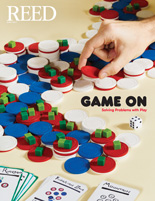
IRIS login | Reed College home Volume 96, No. 2: June 2017
Software Studio Says “Hello, World!”

Reed flexes its codeslinging muscle with new Software Design Studio. (To get technical for a moment, this particular combination is known as an "interpreter directive" in UNIX systems, and confers special powers upon its user.)
Codeslingers, limber up your fingers! Reed is getting ready to launch the new Software Design Studio (SDS) in January.
Bunkered in the basement of Prexy, the SDS will offer hands-on instruction and thoughtful mentorship to help Reed students explore the art and craft of coding.
Many students learn how to write code during their coursework in physics or mathematics, but the SDS is designed to bolster programming skills with practical experience directed by a technologist in residence. It is also aimed at students majoring in disciplines such as classics, music, art, or political science, who have never written a line of code, but are intrigued by the intellectual challenge.
“Reedies are extraordinarily good at problem solving,” says Marty Ringle, chief information officer. “What we hope to provide through the SDS is expert mentorship that will enable any student—not just math and science majors—to solve deep computational problems. This is about bending technology to your will.”
Reed’s first technologist-in-residence is Lennon Day-Reynolds ’03, director of engineering at Urban Airship. Lennon previously worked at Twitter, Sun Microsystems, and Dark Horse Comics.
Lennon, who started life as a music major, anticipates that students at the SDS will work on an array of fascinating projects. Some could arise from their studies, such as the classics major who wants to analyze anaphora in the Iliad. Some could benefit the community, such as “what-if?” scheduling software for students who want to compare what their mornings will look like if they take, say, POL 321 instead of HIST 262. And some might simply appeal to students on an intellectual level, such as designing a program to play the ancient game of Go.
The SDS draws on the college’s proud tradition of integrating technology into the liberal arts. In the ’50s, Prof. John Hancock [chemistry] built the DIMWIT system for molecular analysis, using relays from confiscated pinball machines. In the ’80s, Reed’s pioneering D-Lab produced a host of applications for higher ed, including RASCAL, a real-time Pascal compiler, and the first color graphics system for the Macintosh. In the ’90s, students and professors at the Center for Advanced Computation proved that the 24th Fermat number, a numeric behemoth consisting of five million digits, was not prime. In 2013, Hannah Kosstrin, then-visiting professor of dance, developed the iPad app KineScribe, which allows dancers to use the Labanotation system of choreography notation into the dance studio. (And, there is Steve Jobs . . .)
The SDS will operate on an intern model. Reed students who are selected for the program will be paid on an hourly basis (up to a maximum of 10 hours a week during the school year or 37.5 hours a week during summer and winter break). SDS interns will be paired with mentors who will provide guidance, identify interesting projects to work on, and offer insight into internships, networking, and job-hunting.
The SDS is overseen by an advisory council composed of Reed faculty and staff members and alumni.
“This is an incredible way to create opportunities for students,” says Brooke Hunter, assistant director for strategic partnerships in the Center for Life Beyond Reed. “To start with, it will give students a great experience in software development. These skills will also be invaluable for students who want to go into fields like teaching, finance, art, and design.”
Reed is seeking experienced alumni and local professionals to serve as mentors.
Students interested in becoming an SDS intern should fill out an application by December 1.
--
[Author's Note: I ought to mention that I benefited from a similar kind of experience back when I was a student at Reed. I had picked up some elementary programming skills at the Quest by torturing a laser printer into typesetting newspaper headlines. On that basis, Prof. Richard Crandall ’69 [physics] hired me to assist in his software lab. He taught me the principles of programming as we worked on multitude of computational problems, from modelling the rings of Saturn to mapping fractal sets to designing a poker program that could bluff. Richard's mentorship was invaluable. I drew on his toolbox of problem-solving techniques to write my psychology thesis on handwriting analysis, and I worked as a programmer for several years after Reed until settling on a career in journalism.]
Tags: technology, digital humanities, software, Homer


LATEST COMMENTS
steve-jobs-1976 I knew Steve Jobs when he was on the second floor of Quincy. (Fall...
Utnapishtim - 2 weeks ago
Prof. Mason Drukman [political science 1964–70] This is gold, pure gold. God bless, Prof. Drukman.
puredog - 1 month ago
virginia-davis-1965 Such a good friend & compatriot in the day of Satyricon...
czarchasm - 4 months ago
John Peara Baba 1990 John died of a broken heart from losing his mom and then his...
kodachrome - 7 months ago
Carol Sawyer 1962 Who wrote this obit? I'm writing something about Carol Sawyer...
MsLaurie Pepper - 8 months ago
William W. Wissman MAT 1969 ...and THREE sisters. Sabra, the oldest, Mary, the middle, and...
riclf - 10 months ago